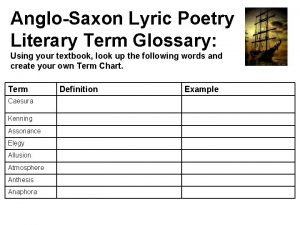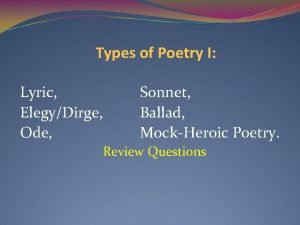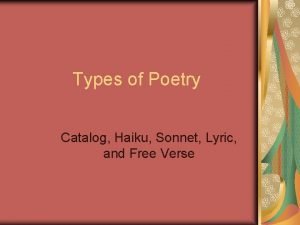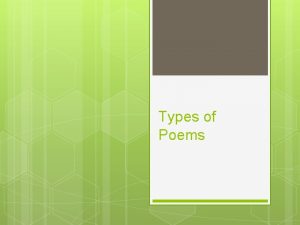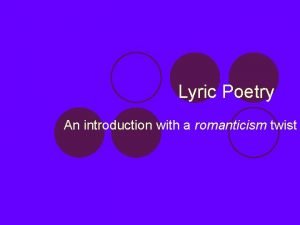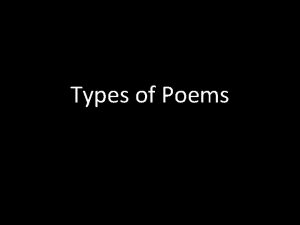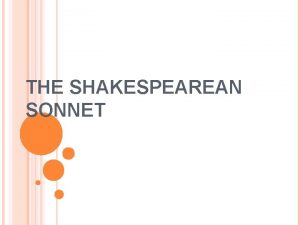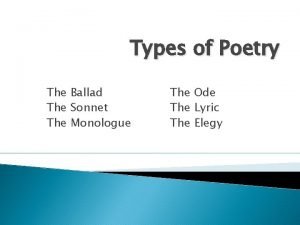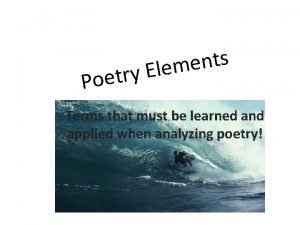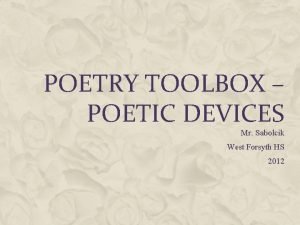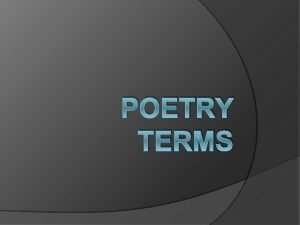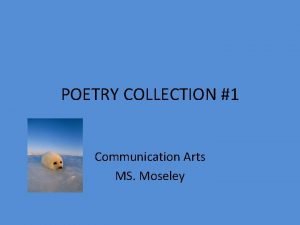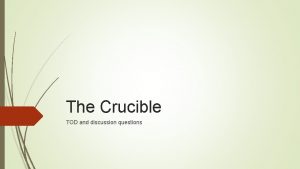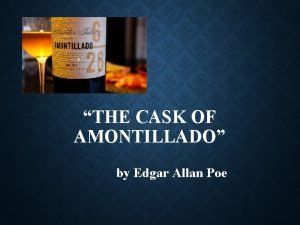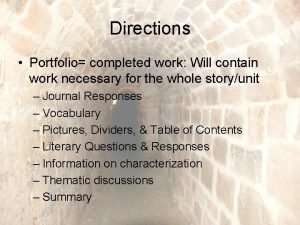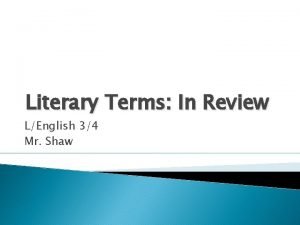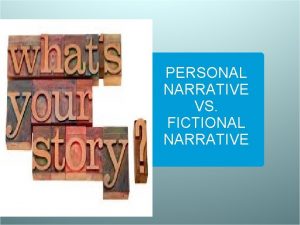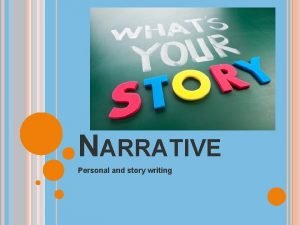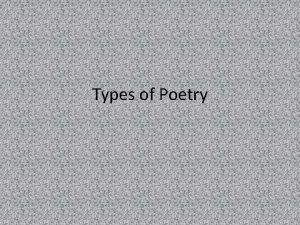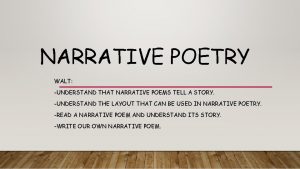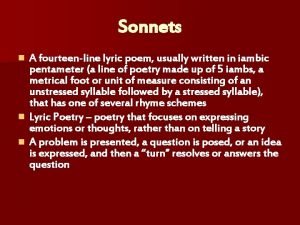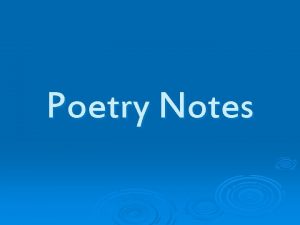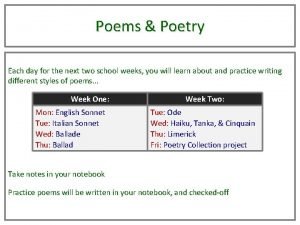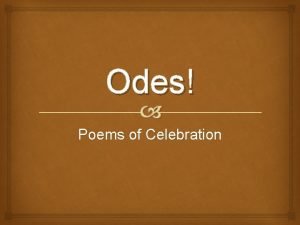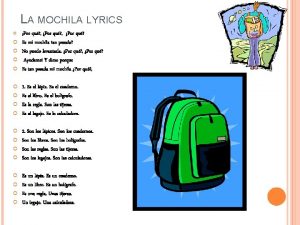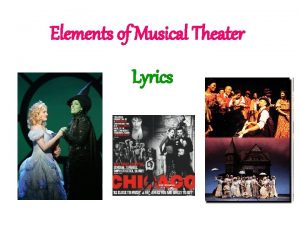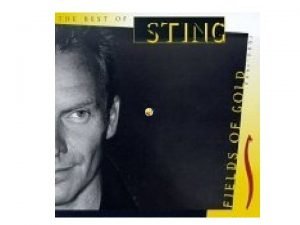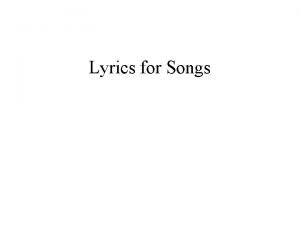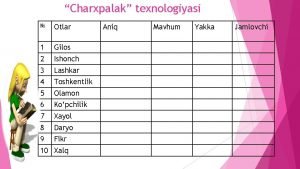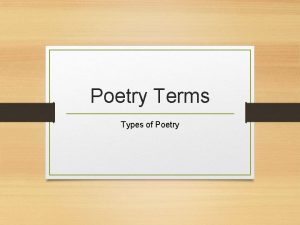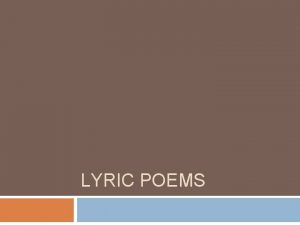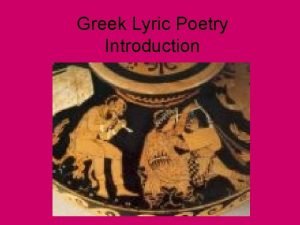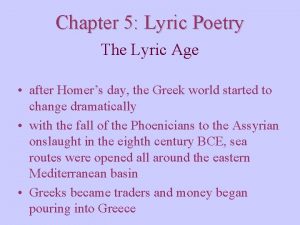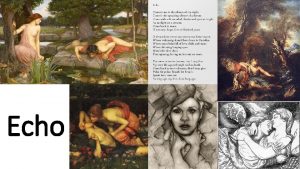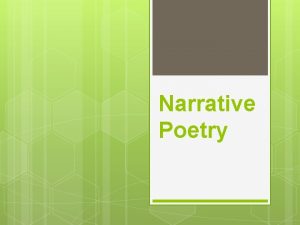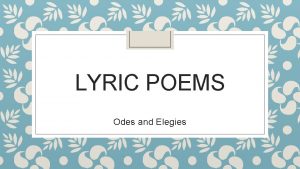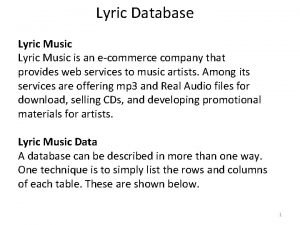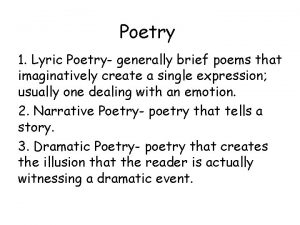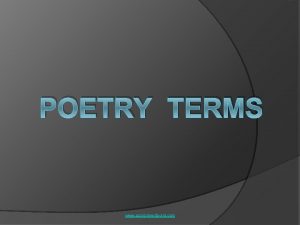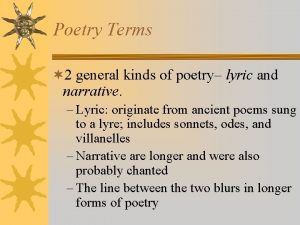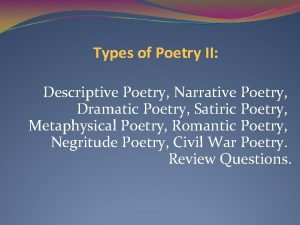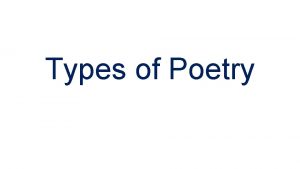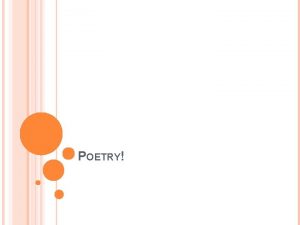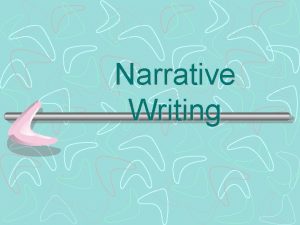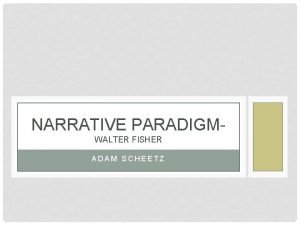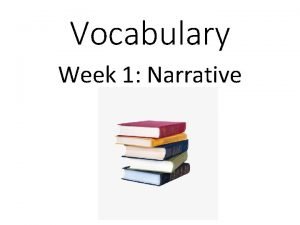Poetry Review Characterize narrative and lyric poetry Which
















































- Slides: 48

Poetry Review • Characterize narrative and lyric poetry. • Which subgenres can you name? • What are their formal, structural, and thematic qualities?

Sonnet Review • What distinguishes the Italian from the English sonnet? • Shakebear’s “Sonnet 27”

Franz Kafka (1888 -1924)

Max Brod



Czech Republic


“An Old Manuscript” • Period: Modernism (published 1919) • Genre: short story

History and Literature • Historical writing and literary writing are typically understood to be different. – – fiction versus nonfiction subjective versus objective variable structure versus historiographically defined genre-based versus information-focused • That said… – Ideological – Related to identity – Arranged as “coherent” narrative

Subject Matter of History • The “proper” subject of history has expanded greatly, but traditionally (and even today) it is somewhat circumscribed. – Political events (history of leadership changes) – Conflicts (wars, revolutions, cultural struggle) – The “great man”; the lives of the powerful – The canon of art – The relation of natural world to human world

Assertions about History • History is unstable; it changes and is periodically rewritten (revisionism). • History is perspectival. • History is not neutral.

Growth and Decline in History • Are there recognizable patterns in history? —for instance, the rise and fall of governments and nations. • We find narratives of growth and decline associated with certain societies, dynasties, or civilizations. • There are many such narratives in the West: the Greeks, the Romans, the Byzantines, Islamic Empire, Charlemagne, the Spanish and Portuguese Empires, the British Empire, and currently, the United States.






Content 1. What is the setting of “An Old Manuscript”? 2. Who is the narrator? 3. What other characters appear? How do we get information about them? 4. To whom is the story directed (audience)? 5. What conflicts appear in the story? 6. Is the conflict resolved (closure)?

Opening Lines • The narrator’s reference to an unknown group • The use of the subjunctive (in German) which obscures agency

Structure • There are different ways to understand structural relations in the text – A bipartite structure – A tripartite structure – A monocentric structure • These models aid us in understanding the conflict of the story.

Bipartite Structure • Capital (center) • Frontier (periphery) • This basic opposition suggests several others, both in general abstract terms and in the specific case of the story.

Tripartite Structure • Emperor • Artisans • Nomads • Again, the specific qualities of representatives of the parts add to our understanding. • On the other hand, as generalizations, we might read these groups as symbolic.

Monocentric/Monoscopic Structure • Mono (one) centric (center), or we might say monoscopic (scopic = view) • Reality is the construction of the narrator’s vision of reality—any element in the story is a representation of his view, and not to be understood as simply objective.

Oppositions in the Text • Labor: Different types of work are described in the story. The distinction partly comes from determining who works and who does not work. • Values: The groups apparently have different value systems. • Communication: Communication is not clearly defined in respect to the story, given that our only view is provided by the narrator. • Property: Partly in relation to values, different or competing notions of property are present in the text —we note this for all three groups.

Problems • The title suggests that the story has survived, but why should it have survived? • Survival suggests power. Why does this survival raise doubts? • This raises problems related to narration, since we might suppose that the situation would be differently narrated by the Emperor or by the nomads.

Groups: Interpretation • I have written down some approaches to this story for your group. • Which ones make sense to your group? Support your ideas. • If you have your own interpretation, then work on that instead.

A. Communication • The story is an allegory of how people cannot communicate with each other. • Questions: – Why can’t they communicate? – What is blocking communication? – What does communication mean?

B. Cultural Understanding • The story represents attitudes towards cultural difference. • The world is understood from a familiar and fixed point; others are judged from this point of view. • Questions: – Why are we able to understand this point? – Does our notion of culture differ substantially from that of the narrator’s?

C. Topos of Historical Change • The story shows an historical pattern (archetype or topos)—old, sedentary civilizations are destroyed by strong, dynamic groups from outside. • Questions: – Why are the nomads successful? – What abstract qualities do they possess which enables them to survive or dominate? – What attitude does the story convey towards such change?

D. Topos of Moral Change • We could make this old/new, weak/strong idea more abstract: old ideas and morals are overturned by newer ones. • Questions: – What kind of morality would each group then represent? – Why can’t the old ideas/morals resist the new or why can’t they adapt? – Why can’t they live side by side? • Think abstractly—for instance, the nomads as the Internet.

E. Allegory of the Human Condition • The story is an allegory which shows human beings as overcome by worldly desires because they cannot join with others to fight them. In this interpretation, the nomads are projections of the townspeople’s desire which they have repressed, but which nonetheless find expression in fantasy. • Questions: – What is the function of the king in this reading? (Note that this interpretation relies on psychoanalysis).

F. Victimization and Chance • The story shows human beings as the powerless victims of forces in a universe run by chance. Moreover, this force is even more frightening because it cannot be understood. • Questions: – Doesn’t this idea suggest that the nomads are simply evil and that we should share the narrator’s values? – How would the nomads tell the story differently?

“Before the Law” • Written 1914/Published 1916 • Genre: parable

Terms • • • alienation archetype authority bureaucracy human condition

The Meaning of law • The word law is a common word. Talk to your group members about – (1) the denotative and connotative meanings of this word, and – (2) the ways that you know how to use this word in English.

Some Usage • The criminal broke the law. (legality) • Newton found new ways to express the laws of nature. (science and mathematics) • Sometimes we do well; sometimes we don’t: that’s the law of averages. (probability) • God gave Moses the tablets of the law (or Law). (morality)

The Origins of Law • Who has the power to make law? • Is it necessary to be outside/above law to create law? • Where do “find” law? Consider your associations and talk to your neighbor for a moment about this point.

Associations • Law might be associated with: – – – a place (city, building, etc. ) an individual (parent, magistrate, president, god, etc. ) a group (representatives, the people, etc. ) a text (book, code, etc. ) history (tradition) enforcers/enforcement of rules (police, army, teacher, etc. ), etc. – or…

Capitalization of Nouns • Sometimes in English we capitalize a common word—this is the case in our story. Capitalizing the word changes the meaning or the way we use or think about the word. What’s the difference? • Examples: school/School, modern/Modern, man/Man—how do these differ? How about law/Law?

The Text • We will listen to Orson Welles read his version of this text at the beginning of his film adaption of The Trial.

Symbols in “Before the Law” • If the man from the country, the doorkeeper, and the Law are symbols, what might they represent? • What allegorical meaning could these symbols, taken together, represent?

Bureaucracy, Authority, Institution • Kafka is sometimes understood to show human relationships in a world dominated by bureaucracy and impersonal agencies/institutions. • Authority takes the form of a giant, anonymous machine which is unconcerned with individual human needs. • Although we feel oppressed by these institutions, at the same time we are unable to locate their source of power; we can’t find anyone to blame or to hold responsible.

Applications to Kafka • Is this interpretation suited to explain “Before the Law”? • How does the story read as a representation of experience with bureaucracy? • What other ways of reading the story can you think of?

Possible Interpretative Directions 1. The story has a religious meaning (or generally antiauthoritarian meaning). 2. The story is an entirely psychological problem happening inside the man’s head. 3. The story concerns responsibility; it problematizes who or what might be responsible for the outcome.

“Give It Up!” • Kafka’s stories are sometimes linked to alienation in modern society. • How does Kafka create a feeling of isolation in “Get It Up!”?

Symbolic Dimensions • Characters, objects, and actions are not clearly developed. They seem dream-like and unrealistic, and partly for this reason, they seem to be abstract symbols rather than real people or things. • What might the narrator and policeman symbolize? • What is “the way”? • What is the narrator’s object in the story, where does he want to go? • What is the meaning of checking his watch against the clock tower—probably a meaningful detail since it is included in such a short story?

For Next Time • Read: Excerpt from Black Boy. • I urge reading over (or watching) the King speech.
 Non narrative poetry
Non narrative poetry Nader amin-salehi
Nader amin-salehi Inclusion criteria examples
Inclusion criteria examples Narrative review vs systematic review
Narrative review vs systematic review Literary terms lyric
Literary terms lyric Sonnet lyric poetry
Sonnet lyric poetry A 14-line lyric poem
A 14-line lyric poem Characteristics of a ballad poem
Characteristics of a ballad poem Element of lyric poetry
Element of lyric poetry Example of lyric poetry
Example of lyric poetry Is sonnet 18 a lyric poem
Is sonnet 18 a lyric poem Kinds of lyric poetry
Kinds of lyric poetry Sonnet lyric poetry
Sonnet lyric poetry Poem vs sonnet
Poem vs sonnet For a lamb richard eberhart
For a lamb richard eberhart Example of narrative poetry
Example of narrative poetry Whats a lyric poetry
Whats a lyric poetry Voyage by carmen tafolla analysis
Voyage by carmen tafolla analysis Great gatsby chapter 3 questions
Great gatsby chapter 3 questions Discussion questions for act 1 of the crucible
Discussion questions for act 1 of the crucible How do you characterize a relationship
How do you characterize a relationship Characterize montresor. what kind of person is he
Characterize montresor. what kind of person is he How does montresor manipulate fortunato
How does montresor manipulate fortunato Characterize examples
Characterize examples Characterize examples
Characterize examples Pygmalion literary devices
Pygmalion literary devices Divya akella
Divya akella Nand flash data retention time
Nand flash data retention time How did democritus characterize atoms
How did democritus characterize atoms Fictional narrative
Fictional narrative Narrative vs story
Narrative vs story A solemn and formal lyric poem about death
A solemn and formal lyric poem about death Chapter review motion part a vocabulary review answer key
Chapter review motion part a vocabulary review answer key Ap gov final review
Ap gov final review Poem that tells a story.
Poem that tells a story. Narrative verse meaning
Narrative verse meaning Elaborate lyric poem
Elaborate lyric poem A poem that tells a story.
A poem that tells a story. Poem about projectile motion
Poem about projectile motion Submitted to in english project
Submitted to in english project Figurative language poem
Figurative language poem Example for ode
Example for ode Ode poems
Ode poems Mochila lyrics
Mochila lyrics Hoglund brain imaging center
Hoglund brain imaging center Musical theatre lyrics
Musical theatre lyrics In europe and america sting
In europe and america sting In him alone lyrics
In him alone lyrics Tushum kelishigi nima
Tushum kelishigi nima




